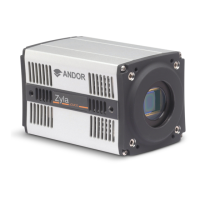version 2.0 rev 18 Feb 2021
27
2.5.2 Pixel Readout Rate
ThePixelReadoutRatedenestherateatwhichpixelsarereadfromthesensor.Thefasterthereadoutrate
the higher the frame rate that can be achieved. The ability to change the pixel readout rate is important to
achievethemaximumexibilityofcameraoperation.
Slower readout typically allows lower read noise but at the expense of slower frame rates. The following
readout rates are available on the Zyla (Table 7 below shows the typical read noise at each readout rate):
• Zyla 5.5:200MHz(100MHzx2halves)and560MHz(280MHzx2halves)
• Zyla 4.2:216MHz(108MHzx2halves)and540MHz(270MHzx2halves)
Table 7: Typical Read Noise for Rolling and Global Shutter modes
Model Rate Read noise (e
-
) Rolling Shutter (typical) Read noise (e
-
) Global Shutter (typical)
Zyla 5.5
200MHz 1.2 2.6
560MHz 1.45 2.6
Zyla 4.2
216MHz 0.9 N/A
540MHz 1.1 N/A
Please refer to Section 2.3 for more information on read noise and the camera performance sheet for read
noise values at the various readout speeds.
2.5.3 ROI Sub-Image Settings
ROI Sub Image allowsforreadoutofaparticularsub-areaofthesensor.Whenasubimagehasbeendened,
onlydatafromtheselectedrowswillbedigitized.
Selecting a sub image increases the frame readout rate and reduces image storage requirements. Examples of
sub-image selection and spooling rates are shown in Table 7.
It should be noted that for small ROIs (e.g. < 512 x 512 pixels), the achievable frame rate for 3-tap and 10-tap
becomes identical. This is due to the fact that the amount of data transmitted across the Camera Link interface
fortheseROIsisrelativelysmallandthelimitingfactorbecomestherateatwhichdatacanbereadothe
sensor.
It should also be noted that while ROIs can also be set up for any area of the sensor, those which are vertically
centred on the sensor mid line will result in the maximum frame rates.

